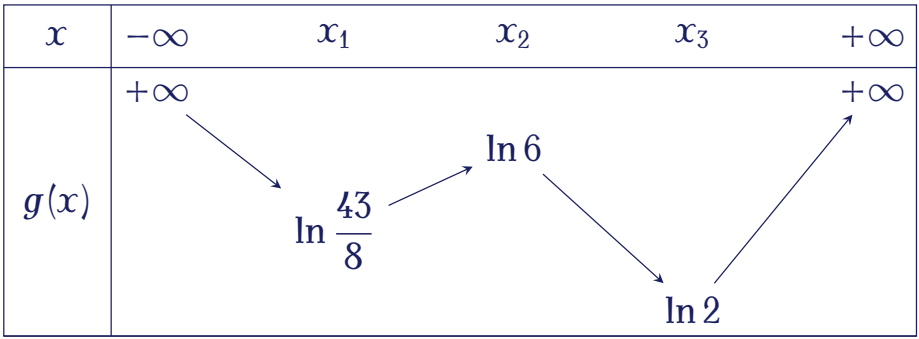Cho hàm số $f(x)$ thỏa mãn $f(x)=x\mathrm{e}^x+\displaystyle\int\limits_{0}^{2}\left(f(x)+f'(x)-\mathrm{e}^x-1\right)\mathrm{\,d}x$. Tính tích phân $\displaystyle\int\limits_{0}^{1}f(x)\mathrm{\,d}x$.
| $2\mathrm{e}^2-1$ | |
| $-2\mathrm{e}^2-1$ | |
| $-2\mathrm{e}^2+1$ | |
| $2\mathrm{e}^2+1$ |
Xét hàm số $f(x)=\mathrm{e}^x+\displaystyle\int\limits_{0}^{1}xf(x)\mathrm{\,d}x$. Giá trị $f\left(\ln5620\right)$ bằng
| $5622$ | |
| $5620$ | |
| $5618$ | |
| $5621$ |
Cho $F(x)$ là một nguyên hàm của hàm số $f(x)$ trên đoạn $[1;3]$, $F(1)=3$, $F(3)=5$ và $\displaystyle\displaystyle\int\limits_1^3\left(x^4-8x\right)f(x)\mathrm{\,d}x=12$. Tính $I=\displaystyle\displaystyle\int\limits_1^3\left(x^3-2\right)F(x)\mathrm{\,d}x$.
| $I=\dfrac{147}{2}$ | |
| $I=\dfrac{147}{3}$ | |
| $I=-\dfrac{147}{2}$ | |
| $I=147$ |
Biết $F(x)=-\dfrac{1}{x^2}$ là một nguyên hàm của hàm số $y=\dfrac{f(x)}{x}$. Tính $\displaystyle\displaystyle\int f'(x)\ln{x}\mathrm{\,d}x$.
| $\displaystyle\displaystyle\int\limits f'(x)\ln{x}\mathrm{\,d}x=-\dfrac{2\ln{x}}{x^2}+\dfrac{1}{x^2}+C$ | |
| $\displaystyle\displaystyle\int\limits f'(x)\ln{x}\mathrm{\,d}x=\dfrac{2\ln{x}}{x^2}+\dfrac{1}{x^2}+C$ | |
| $\displaystyle\displaystyle\int\limits f'(x)\ln{x}\mathrm{\,d}x=\dfrac{2\ln{x}}{x^2}-\dfrac{1}{x^2}+C$ | |
| $\displaystyle\displaystyle\int\limits f'(x)\ln{x}\mathrm{\,d}x=-\dfrac{2\ln{x}}{x^2}-\dfrac{1}{x^2}+C$ |
Cho hàm số $y=f(x)$ liên tục, thỏa mãn $f(x)=x\left(1+\dfrac{1}{\sqrt{x}}-f'(x)\right)$, $\forall x\in(0;+\infty)$ và $f(4)=\dfrac{4}{3}$. Giá trị của $\displaystyle\displaystyle\int\limits_{1}^{4}\left(x^2-1\right)f'(x)\mathrm{\,d}x$ bằng
| $\dfrac{457}{15}$ | |
| $\dfrac{457}{30}$ | |
| $-\dfrac{263}{30}$ | |
| $-\dfrac{263}{15}$ |
Biết rằng \(I=\displaystyle\int\limits_{1}^{a}\dfrac{\ln x}{x^2}\mathrm{\,d}x=\dfrac{1-\ln2}{2}\). Giá trị của \(a\) bằng
| \(2\) | |
| \(\ln2\) | |
| \(4\) | |
| \(8\) |
Cho hàm số \(y=f(x)\) có đạo hàm liên tục trên \(\mathbb{R}\) và thỏa mãn \(f(2)=16\), \(\displaystyle\int\limits_{0}^{2}f(x)\mathrm{\,d}x=4\). Tính \(I=\displaystyle\int\limits_{0}^{1}xf'(2x)\mathrm{\,d}x\).
| \(I=13\) | |
| \(I=20\) | |
| \(I=12\) | |
| \(I=7\) |
Hàm số \(y=f(x)\) liên tục trên \([1;4]\) và thỏa mãn \(f(x)=\dfrac{f\left(2\sqrt{x}-1\right)}{\sqrt{x}}+\dfrac{\ln x}{x}\). Tính tích phân \(I=\displaystyle\int\limits_{3}^{4}f(x)\mathrm{\,d}x\).
| \(I=3+2\ln^22\) | |
| \(I=\ln^2\) | |
| \(I=2\ln2\) | |
| \(I=2\ln^22\) |
Kết quả của phép tính tích phân \(\displaystyle\int\limits_{0}^{1}\ln(2x+1)\mathrm{\,d}x=a\ln3+b\), (\(a,\,b\in\mathbb{Q}\)) khi đó giá trị của \(ab^3\) bằng
| \(-\dfrac{3}{2}\) | |
| \(3\) | |
| \(1\) | |
| \(\dfrac{3}{2}\) |
Cho hàm số bậc bốn $y=f(x)$. Biết rằng hàm số $g(x)=\ln f(x)$ có bảng biến thiên như sau:

Diện tích hình phẳng giới hạn bởi các đường $y=f'(x)$ và $y=g'(x)$ thuộc khoảng nào dưới đây?
| $(5;6)$ | |
| $(4;5)$ | |
| $(2;3)$ | |
| $(3;4)$ |
Cho hàm số $f\left(x\right)$ thỏa mãn $f\left(2\right)=25$ và $f'\left(x\right)=4x\sqrt{f\left(x\right)}$ với mọi $x\in\mathbb{R}$. Khi đó $\displaystyle\displaystyle\int\limits_2^3f\left(x\right)\mathrm{\,d}x$ bằng
| $\dfrac{1073}{15}$ | |
| $\dfrac{458}{15}$ | |
| $\dfrac{838}{15}$ | |
| $\dfrac{1016}{15}$ |
Xét tích phân $I=\displaystyle\displaystyle\int\limits_1^{\rm{e}^2}\dfrac{\left(1+2\ln x\right)^2}{x}\mathrm{\,d}x$, nếu đặt $t=1+2\ln{x}$ thì $I$ bằng
| $\dfrac{1}{2}\displaystyle\displaystyle\int\limits_1^{e^2}t^2\mathrm{\,d}t$ | |
| $2\displaystyle\displaystyle\int\limits_1^5t^2\mathrm{\,d}t$ | |
| $2\displaystyle\displaystyle\int\limits_1^{e^2}t^2\mathrm{\,d}t$ | |
| $\dfrac{1}{2}\displaystyle\displaystyle\int\limits_1^5t^2\mathrm{\,d}t$ |
Cho hàm số $f(x)$ có đạo hàm liên tục trên $\mathbb{R}$, thỏa mãn $f(x)+2f(2-x)=x^2-6x+4$. Tích phân $\displaystyle\displaystyle\int\limits_{-1}^3x f^{\prime}(x)\mathrm{d}x$ bằng
| $20$ | |
| $\dfrac{149}{3}$ | |
| $\dfrac{167}{3}$ | |
| $\dfrac{176}{9}$ |
Tích phân $\displaystyle\displaystyle\int\limits_{0}^{10}x\mathrm{e}^{30x}\mathrm{\,d}x$ bằng
| $\dfrac{1}{900}\left(299\mathrm{e}^{300}+1\right)$ | |
| $300-900\mathrm{e}^{300}$ | |
| $-300+900\mathrm{e}^{300}$ | |
| $\dfrac{1}{900}\left(299\mathrm{e}^{300}-1\right)$ |
Cho hàm số $f(x)$ liên tục trên $\mathbb{R}$ thỏa mãn $f(x)=3x^2-2x+3+4\displaystyle\int\limits_{0}^{1}xf\left(x^2\right)\mathrm{\,d}x$. Khi đó $\displaystyle\int\limits_{2}^{3}f(x)\mathrm{\,d}x$ bằng
| $17$ | |
| $11$ | |
| $14$ | |
| $21$ |
Cho hàm số $f(x)$ có đạo hàm liên tục trên $\mathbb{R}$ thỏa mãn $f(x)=x^2-3x+2\displaystyle\int\limits_{0}^{1}f(x)f'(x)\mathrm{\,d}x$. Khi đó $\displaystyle\int\limits_{0}^{2}f(x)\mathrm{\,d}x$ bằng
| $\dfrac{10}{3}$ | |
| $-\dfrac{10}{3}$ | |
| $\dfrac{26}{15}$ | |
| $-\dfrac{26}{15}$ |
Cho hàm số $f(x)$ liên tục trên $\mathbb{R}$ thỏa $f(x)=\sin x+2\displaystyle\int\limits_{0}^{\tfrac{\pi}{2}}\cos x\cdot f(x)\mathrm{\,d}x$. Giá trị $f\left(-\dfrac{\pi}{2}\right)$ bằng
| $-\pi$ | |
| $-1$ | |
| $-2$ | |
| $0$ |
Cho hàm số $f(x)$ xác định và liên tục trên đoạn $[0;1]$ thỏa mãn $f(x)=x^3+\displaystyle\int\limits_{0}^{1}x^3f\left(x^2\right)\mathrm{\,d}x$, $\forall x\in[0;1]$. Tính tích phân $\displaystyle\int\limits_{0}^{1}f(x)\mathrm{\,d}x$.
| $\dfrac{1}{4}$ | |
| $\dfrac{4}{15}$ | |
| $\dfrac{13}{20}$ | |
| $\dfrac{23}{60}$ |
Cho hàm số $f(x)$ xác định và liên tục trên $[0;+\infty)$ thỏa mãn $f(x)=x\sqrt{x}+\displaystyle\int\limits_{0}^{1}xf(x)\mathrm{\,d}x$. Tính tích phân $\displaystyle\int\limits_{0}^{4}f(x)\mathrm{\,d}x$.
| $\dfrac{528}{35}$ | |
| $\dfrac{488}{35}$ | |
| $\dfrac{408}{35}$ | |
| $\dfrac{368}{35}$ |
Cho hàm số $f(x)$ xác định và liên tục trên khoảng $(0;+\infty)$ thỏa mãn $f(x)=\dfrac{1}{x}+\displaystyle\int\limits_{1}^{2}xf(x)\mathrm{\,d}x$, $\forall x\in(0;+\infty)$. Tính tích phân $\displaystyle\int\limits_{1}^{\mathrm{e}}f(x)\mathrm{\,d}x$.
| $\dfrac{5-2\mathrm{e}}{3}$ | |
| $3-2\mathrm{e}$ | |
| $2+2\mathrm{e}$ | |
| $1-2\mathrm{e}$ |
